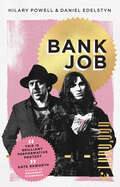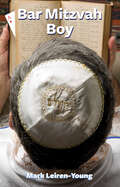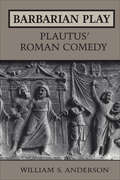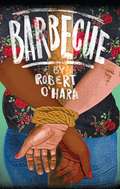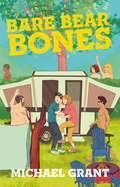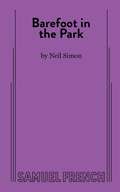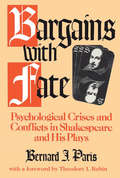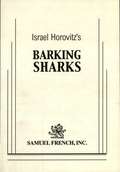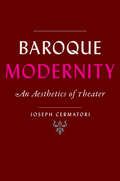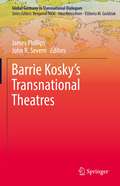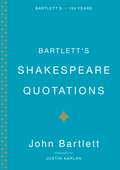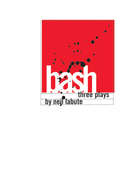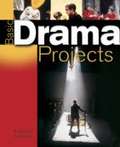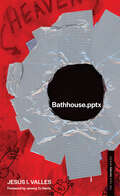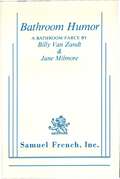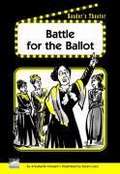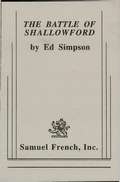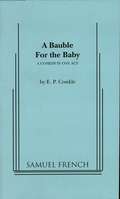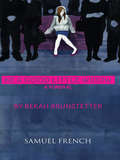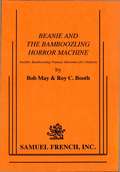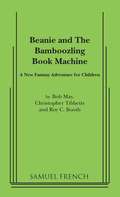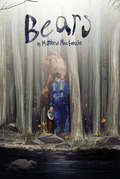- Table View
- List View
Bangkok
by Antonio Morcillo Lopez Ieie PaolaIn un aeroporto vuoto del territorio spahnolo appare un misterioso aniano con un biglietto per andare a Bangkok. Lì incontra l'unica persona che lavora nella struttura: una giovane guardia fi dise encuentra con la única persona que aún trabaja en las instalaciones: un joven guardia di sicurezza. Questi lo ingorma dell'impossibilità di realizzare il viaggio pianificato: lì non ci sono, non ce ne somo mai stati. Si tratta di un aeroporto inaugurato da molto tempo, ma mai operativo. Davanti all'incredulità e all'insistenza del vecchio, la guardia di sicurezza gli permette di fermarsi. A partire da quel momento, inizierà tra i due un dialogo in cui non sol discuteranno delle proprie vite, dei rispettivi lavori e della situazione politica in cui sono immersi, ma sveleranno anche la vera natura del loro incontro.
Bank Job
by Hilary Powell Daniel EdelstynArt hacks life when two filmmakers launch a project to cancel more than £1m of high-interest debt from their local community. Bank Job is a white-knuckle ride into the dark heart of our financial system, in which filmmaker and artist duo Hilary Powell and Dan Edelstyn risk their sanity to buy up and abolish debt by printing their own money in a disused bank in Walthamstow, London. Tired of struggling in an economic system that leaves creative people on the fringes, the duo weave a different story, both risky and empowering, of self-education and mutual action. Behind the opaque language and defunct diagrams, they find a system flawed by design but ripe for hacking. This is the inspiring story of how they listen and act upon the widespread desire to change the system to meet the needs of many and not just the few. And for those among us brave enough, they show how we can do this too in our own communities one bank job at a time.
Bar Mitzvah Boy
by Mark Leiren-YoungMark has had books published by Anvil Press, Knopf, Greystone Books, Orca Books, and more.
Barbarian Play: Plautus' Roman Comedy
by William AndersonIn this volume William S. Anderson sets Plautus, who wrote Rome's earliest surviving poetry, in his rightful place among the Greek and Roman writers of what we know as New Comedy (fourth to second centuries). Anderson begins by defining major innovations that Plautus made on inherited Greek New Comedy (Menander, Philemon, and Diphilus), transforming it from romantic domestic drama to a celebration of rollicking family anarchy. He shows how Plautus diminished the traditional importance of love and replaced it with a new major theme: 'heroic badness,' especially embodied in the rogue slave (ancestor of the impudent servant, valet, or maid). Anderson then examines the unique verbal texture of Plautus' drama and demonstrates his revolt against realism, his drive to have his characters defy everyday circumstances and pit their intrepid linguistic wit against social order, their Roman extravagant impudence against Greek self-control. Finally, Anderson explores the special form of metatheatre that we admire in Plautus, by which he undermines the assumptions of his Greek 'models' and replaces them with a new, confident Roman comedy.
Barbecue / Bootycandy (TCG Edition)
by Robert O'HaraSutter is on an outrageous odyssey through his childhood home, his church, dive bars, motel rooms, and even nursing homes. The journey uncovers characters who are at once fascinating, zany, controversial, and even a bit smutty, painting a portrait of life as a societal outlier. Based on the author's personal experience, Bootycandy is a kaleidoscope of sketches that interconnects to portray growing up gay and black. This subversive, uproarious satire crashes headlong into the murky terrain of pain and pleasure and . . . BOOTYCANDY!
Bare Bear Bones
by Michael GrantAt the instruction of their marriage counsellor, empty nesters Norm and Ruth book a trip to a place where they remember being in love, the Bear Bones Family Campground, in order to rekindle their spark. After arriving late in the night, the conservative couple wakes to discover that their once familiar spot has become the Bare Bones Alternative Lifestyle Campground, and that nobody else is wearing any clothes! Besides figuring out which side of the clothesline they’re on, Norm and Ruth have to work on their communication, whether it’s blindly directing one another to the washroom or re-establishing their goals in life. With the help of guests and staff, the couple starts to open their eyes and find their way back to their happy place.
Barefoot in the Park
by Neil SimonPaul and Corie Bratter are newlyweds in every sense of the word. He's a straight-as-an-arrow lawyer and she's a free spirit always looking for the latest kick. Their new apartment is her most recent find-too expensive with bad plumbing and in need of a paint job. After a six day honeymoon, they get a surprise visit from Corie's loopy mother and decide to play matchmaker during a dinner with their neighbor-in-the-attic Velasco, where everything that can go wrong, does.
Bargains with Fate: Psychological Crises and Conflicts in Shakespeare and His Plays
by Maria JaroszThe enduring appeal of Shakespeare's works derives largely from the fact that they contain brilliantly drawn characters. Interpretations of these characters are products of changing modes of thought, and thus past explanations of their behavior, including Shakespeare's, no longer satisfy us. In this work, Bernard J. Paris, an eminent Shakespearean scholar, shows how Shakespeare endowed his tragic heroes with enduring human qualities that have made them relevant to people of later eras.Bargains with Fate employs a psychoanalytic approach inspired by the theories of Karen Horney to analyze Shakespeare's four major tragedies and the personality that can be inferred from all of his works. This compelling study first examines the tragedies as dramas about individuals with conflicts like our own who are in a state of crisis due to the breakdown of their bargains with fate, a belief that they can magically control their destinies by living up to the dictates of their defensive strategies.Filled with bold hypotheses supported by carefully detailed accounts, this innovative study is a resource for students and scholars of Shakespeare, and for those interested in literature as a source of psychological insight. The author's combination of literary and psychoanalytic perspectives guides us to a humane understanding of Shakespeare and his protagonists, and, in turn, to a more profound knowledge of ourselves and human behavior.
Barking Sharks
by Israel HorovitzA solid hit with diverse audiences in Gloucester, New York City and Fairbanks, this startling town and country drama is built around the son of a Gloucester fisherman who finds himself, at age forty, living in New York City where he runs a hip ad agency in Tribeca. He dreams of his roots: of being a fisherman in the waters off Massachusetts. When he does follow his dream back to Gloucester, he brings havoc into the lives of friends and family. "Harrowing.... A sweeping epic."—Boston Herald . "Brilliant! A great, swashbuckling story!"—Fairbanks Daily News Miner. FEE: $75 per performance.. Amateurs may apply for video recording rights for this title.
Baroque Modernity: An Aesthetics of Theater (Hopkins Studies in Modernism)
by Joseph CermatoriA groundbreaking study on the vital role of baroque theater in shaping modernist philosophy, literature, and performance.Winner, Helen Tartar First Book Subvention AwardBaroque style—with its emphasis on ostentation, adornment, and spectacle—might seem incompatible with the dominant forms of art since the Industrial Revolution, but between 1875 and 1935, European and American modernists connected to the theater became fascinated with it. In Baroque Modernity, Joseph Cermatori argues that the memory of seventeenth-century baroque stages helped produce new forms of theater, space, and experience around the turn of the twentieth century. In response, modern theater helped give rise to the development of the baroque as a modern philosophical idea. The book focuses on avant-gardists whose writing takes place between theory and performance: philosophical theater-makers and theatrical philosophers including Friedrich Nietzsche, Stéphane Mallarmé, Walter Benjamin, and Gertrude Stein. Moving between page and stage, this study tracks the remnants of seventeenth-century theater through modernist aesthetics across an array of otherwise disparate materials, including modern opera, Bertolt Brecht's Epic Theater, poetic tragedies, and miracle plays. By reexamining the twentieth century's engagements with Gianlorenzo Bernini, William Shakespeare, Claudio Monteverdi, Calderón de la Barca, and other seventeenth-century predecessors, the book delineates an enduring tradition of baroque performance. Along the way, Cermatori expands our familiar narratives of "the modern" and traces a history of theatricality that reverberates into the twenty-first century. Baroque Modernity will appeal to readers in a wide array of disciplines, including comparative literature, theater and performance, art and music history, intellectual history, and aesthetic theory.
Barrie Kosky on the Contemporary Australian Stage: Affect, Post-Tragedy, Emergency (Routledge Advances in Theatre & Performance Studies)
by Charlotte FarrellThis is the first book-length study of Australian theatre productions by internationally-renowned director, Barrie Kosky. Now a prolific opera director in Europe, Barrie Kosky on the Contemporary Australian Stage accounts for the formative years of Kosky's career in Australia. This book provides in-depth engagements with select productions including The Dybbuk which Kosky directed with Gilgul theatre company in 1991, as well as King Lear (1998), The Lost Echo (2006), and Women of Troy (2008). Using affect theory as a prism through which these works are analysed, the book accounts for the director's particular engagement with – and radical departure from – classical tragedy in contemporary performance: what the book defines as Kosky's 'post-tragedies'. Theatre studies scholars and students, particularly those with interests in affect, contemporary performance, 'director's theatre', and tragedy, will benefit from Barrie Kosky on the Contemporary Australian Stage’s vivid engagement with Kosky's work: a director who has become a singular figure in opera and theatre of international critical acclaim.
Barrie Kosky’s Transnational Theatres (Global Germany in Transnational Dialogues)
by James Phillips John R. SevernThis book, the first of its kind, surveys the career of the renowned Australian-German theatre and opera director Barrie Kosky. Its nine chapters provide multidisciplinary analyses of Barrie Kosky’s working practices and stage productions, from the beginning of his career in Melbourne to his current roles as Head of the Komische Oper Berlin and as a guest director in international demand. Specialists in theatre studies, opera studies, musical theatre studies, aesthetics, and arts administration offer in-depth accounts of Kosky’s unusually wide-ranging engagements with the performing arts – as a director of spoken theatre, operas, musicals, operettas, as an adaptor, a performer, a writer, and an arts manager. Further, this book includes contributions from theatre practitioners with first-hand experience of collaborating with Kosky in the 1990s, who draw on interviews with members of Gilgul, Australia’s first Jewish theatre company, to document this formative period in Kosky’s career. The book investigates the ways in which Kosky has created transnational theatres, through introducing European themes and theatre techniques to his Australian work or through bringing fresh voices to the national dialogue in Germany’s theatre landscape. An appendix contains a timeline and guide to Kosky’s productions to date.
Bartlett's Shakespeare Quotations
by Justin Kaplan John BartlettFrom the quote aficionado to the historical researcher, fans of Bartlett's will be thrilled to see this edition of quotations from the great William Shakespeare. Collecting quotes from his many works into one beautiful volume, Bartlett's Shakespeare Quotations is essential as a reference tool and makes for some wonderful browsing. Quotes culled from Bartlett's Familiar Quotations are organised by play or sonnet in chronological order and capture a unique view of Shakespeare's life and work. From King Henry VI to The Tempest (and even the epitaph on his grave) this volume will delight both researchers and casual readers as it highlights one of the most beguiling and beloved playwrights in history.
Bash: Three Plays
by Neil LabuteA trio of brilliantly scathing plays by the renowned writer-director of In the Company of Men and Your Friends and Neighbors. With the success of his first two films, In The Company of Men and Your Friends and Neighbors, writer-director Neil LaBute has been hailed as a first-rate dramatic talent with a caustic wit reminiscent of Stanley Kubrick. bash—a collection of three stunning one-act plays that mark LaBute’s return to the New York stage after ten years—forms a trio of unforgettable personal accounts: in Medea Redux, a woman tells of her complex and ultimately tragic relationship with her grade school English teacher; in Iphigenia in Orem, a Utah businessman confides in a stranger in a Las Vegas hotel room, confessing a most chilling crime; and in A Gaggle of Saints, a young Mormon couple separately recounts the violent events of an anniversary weekend in New York City. All three are unblinking portraits of the complexities of evil in everyday life, exhibiting LaBute’s signature raw lyrical intensity.
Basic Drama Projects
by Fran A. TannerThis seventh edition contains the same philosophy as the previous editions. The changes include updated material and additional information. New material includes: 1. Student outcomes or chapter objectives which focus students on specific knowledge, performances, and critical thinking skills. 2. New chapters on playwriting and careers in the theatre. 3. A chapter on theatre history that includes basic material as well as current information on modern theatre and much more.
Basic Drama Projects
by Fran Averett TannerThis is a project-based theatre text, designed for group or individual participation in pantomimes, improvisations, scenes, talks, make-up activities, and play performances.
Bathhouse.pptx (Yale Drama Series)
by Jesus I VallesThe sixteenth winner of the Yale Drama Prize, a big-hearted evocation of queer intimacy set in a bathhouse at the end of the world In this love letter to queer bathhouse culture, the Presenter, a Mexican-American public-speaking student, is thrust into the landscapes of queer intimacy, colonialism, and erotic community when their class presentation on the history of cleanliness and bathing starts to unravel. What had been a single presentation soon becomes a chorus, joining student presenters with the ghosts of bathhouses past, present, and future, along with the cleaning staff, A Conquistador!, and officials from the Centers for Disease Control, to explore queer desire and the gleeful delights of messiness. Here in the bathhouse at the end of the world, Jesús I. Valles conjures the ever-present yearning for skin to touch skin, a place of connection that shimmers in the steam of the bathhouse and refuses to ever fully fade. Bathhouse.pptx is the sixteenth winner of the Yale Drama Series prize and first winner chosen by Tony-nominated playwright Jeremy O. Harris.
Bathroom Humor: A Bathroom Farce
by Jane Milmore Billy Van ZandtVan Zandt and Milmore have done it again! This hilarious new farce from the authors of Love, Sex and the I.R.S. have certainly come up with a novel setting: the play takes place in the bathroom in a home during a party, a handy place for gossip and hanky panky, where we learn of the wild and crazy things going on at the party. The authors have ingeniously contrived this play so that we feel that, if we had gone to this party we, too, might have spent most of our time hiding out in the bathroom! Definitely recommended for dinner theatre, community theatre, and summer stock audiences. “Zany! Action-packed fun! Funny as all get-out!”" - Asbury Park Press "A romp worthy of a night out!” - The Post and Courier “Slick, sophisticated, and thoroughly funny! Throws jokes at the audience one after another in wild, outrageous, zany action-packed fun!” - West Liberty News, Wheeling, West Virginia Bathroom Humor opened at the Mill Dam Dinner-Theater, Tinton Falls, New Jersey, on June 20, 1986. It was produced by Kathy Reed and directed by Billy Van Zandt. 5m / 3f
Battle of Shallowford
by Ed SimpsonComedy / 8m, 1f / On a quiet Sunday night in October of 1938 at Burton Mock's general store in Shallowford, NC. Burton and his teenage daughter, Ruthie, are discussing her future. She's convinced she can handle life outside the rural Shallowford, her father would like her to stay close. As the night progresses, a host of colorful locals arrive at the store, including science obsessed, 17 year old Lonny. The rest of the world is on the brink of war, but these folks are only interested in local gossip until they turn on the radio and learn that the Martians have invaded! It is the night of Orson Welles' history War of the Worlds radio drama! They fall hook, line and sinker for the broadcast and run out to do battle. Lonny and Ruthie must fend for themselves inside the store, and they discover a mutual passion for that which is unknown and each other....a community theatre classic that rings true with anyone who ever lived in a small town or had big dreams! . "A theatrical gem." Ashville Citizen Times. . "Tickle their funny bones, warm their hearts, don't insult their intelligence.... The Battle of Shallowford hits that magic trio." Knoxville News Sentinel. . "Hilariously on target...A community theatre staple." Knoxville Journal. . FEE: $75 per performance.. Click below for additional materials: . Sound Effects CD. Other Ed Simpson titles available from Samuel French include: Additional Particulars The Comet of St. LoomisElephant Sighs A Point of Order
Bauble for Baby
by E. P. ConkleComedy / 1m, 3f / Interior / A delightful sequel to the popular Sparkin' with the same delightful characters: Lessie, Orry, Susan, and Granny Painsberry. Takes place a year or so after Sparkin' and centers around Lessie and Orry's new baby and a Christmas present Orry has just made for the little one.
Be A Good Little Widow
by Bekah BrunstetterDramatic Comedy / 2m, 2f / Interior / Young wife Melody has never been to a funeral - until her husband dies in a plane crash. Expected to instantly assume proper widowhood, Melody is left to wonder, what's the right way to grieve? Fortunately, her mother-in-law is a professional. Widow, that is. Under her guidance, Melody must try her best to be a good little widow. A sad comedy about loss and longing. / "Delicately satisfying...[Ms. Brunstetter] writes fresh, unfussy dialogue and characters who earn their laughs and emotional moments by honest means." -The New York Times
Beanie And The Bamboozling Horror Machine
by Bob May Roy C. BoothThis highly anticipated sequel to Beanie and the Bamboozling Book Machine has Beanie once again trying to win the science fair, but this time with his new and improved book machine! But something nasty is afoot in Bookworld and an evil mastermind wants to turn everyone there into an obedient zombie! Not only are the original fairytale characters (Hansel & Gretel, Snow White, Dorothy) released from their stories, but also villains like Dracula, Frankenstein's Monster, Mr. Hyde, and, once again, the Wicked Witch of the West! Can Beanie save the day, and who IS behind all of this? FEE: $75 per performance.
Beanie and The Bamboozling Book Machine
by Bob May Christopher Tibbetts Roy C. BoothFantasy / 13 m.& f. / Beanie Boren, a science wiz who is not keen on reading, has designed a book reading machine for the science fair. It combines a computer, a mini video cam and a contraption of his own design to enable one to read three books at once. Unfortunately, the machine is neither user friendly nor bug free. When Beanie turns it on, lights flash, thunder booms and out pop the witches from Snow White, Hansel and Gretel and the The Wizard of Oz, each set to wreak havoc! Beanie must get them back into the books with help from the good guys in the same stories. Afterward, he is eager to read about his new friends-- the old fashioned way.
Bears
by Matthew MacKenzieAs the prime suspect in a workplace accident, Floyd has to get out of town fast. Pursued by the RCMP, he heads through the Rockies for Burnaby, BC, along the route of the Trans Mountain Pipeline. By the time he reaches the Pacific, Floyd has experienced changes: his gait widening, muscles bulging, sense of smell heightening…

